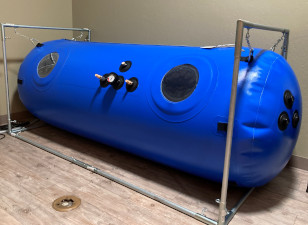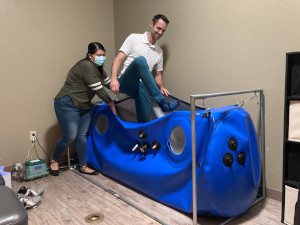
Chiropractor Chandler AZ
Hyperbaric Oxygen Therapy for Military TBI and Post-Traumatic Stress Disorder
Improvements in military body armour and medical technology have resulted in more soldiers surviving acute trauma from explosive devices such as IEDs (Eve et al., 2016). As a result, increased numbers of veterans are suffering the lingering consequences of these injuries, with a limited arsenal of therapeutic treatments. While pharmacotherapy is helpful in some cases, accumulating evidence endorses hyperbaric oxygen therapy (HBOT) as a method of ameliorating both the physical and psychological effects of TBI.
The impact of these injuries on quality of life is more significant than many people realize, with estimates of 20 suicides per day among US military veterans (Stoller, 2015). Although HBOT has yet to receive FDA approval for treatment of TBI, both preclinical animal studies and studies on human subjects have yielded positive results that include reduction in the number and severity of headaches, improved sleep quality, reduction in depression and anxiety (Eve et al., 2016). In fact, HBOT has been used globally in combat situations to treat PTSD and high altitude cerebral edema (Verghese et al., 2012). Reduced cost and portability of new monoplace HBOT chambers makes the use of this therapy in combat treatment centers more feasible (Verghese et al., 2012).
How does hyperbaric oxygen therapy work?
Oxygen is essential for human life. This is especially true for cells in the brain, which die quickly if starved for oxygen: a condition known as ischemia. The body’s circulatory system delivers oxygen to various tissues and organs in the body and cycles carbon dioxide back to the lungs to be expelled. Most oxygen in the blood is attached to hemoglobin; a much smaller percentage is dissolved in the blood plasma.

In hyperbaric oxygen therapy, the patient breathes in pure oxygen while lying in a chamber pressurized above one atmosphere (1 ATA), which is the pressure at sea level (Schaefer, 1992). Doing so enables the blood plasma to absorb significantly more oxygen, which can be delivered to injured tissue. This in turn speeds up metabolic processes so the tissue can heal (Eve et al., 2016). In addition, HBOT decreases inflammation in the injured area, and promotes the migration of satellite cells (regional stem cells) that replace cells that have been damaged by injury (Eve et al., 2016). Some studies also suggest that HBOT improves neovascularization: the development of new capillary networks needed to deliver blood to the injured tissue (Eve et al., 2016).
Fortunately, oxygen can easily cross the blood brain barrier (BBB), which means that oxygen inhaled through the lungs can travel to the brain (Stoller, 2015). HBOT sessions lasting up to two hours at pressures up to 3 ATA are considered safe and effective (Tibbles & Edelsberg, 1996).
Clinical trials

For ethical reasons, many of the studies on the pathophysiology of HBOT have been performed with animals. However, there have been non-invasive studies on human subjects. Notable for the use of HBOT to treat TBI and PTSD resulting from combat injuries was a randomized controlled trial involving 63 military and civilian personnel with documented persistent postconcussion syndrome (PPCS), defined as symptoms lingering at least three years after the acute injury (Harch et al., 2020). The study was a crossover case control design, meaning that each subject received the treatment and treatment results were compared to a period of no treatment on the same person. The primary outcome measures were the neurobehavioral symptom inventory (NSI) and working memory index (Harch et al., 2020).
Results indicated that HBOT improved NSI scores 19% more than no treatment, which is both clinically and statistically significant. Executive function (decision making) and sleep quality were also significantly improved following treatment. While working memory improved, the improvements were not statistically significant as compared to the treatment group (Harch et al., 2020). Importantly, patients experienced continuing improvement in working memory, information processing, IQ and executive function for two months after the last HBOT treatment (Harch et al., 2020).
Hyperbaric oxygen therapy protocol
There are two types of hyperbaric chambers: large multiplace chambers that hold eight patients and an overseer, and monoplace chambers that hold a single patient (Schaefer, 1992). The former are more common in tertiary care facilities (hospitals), while most outpatient clinics use the single chambers (Tibbles & Edelsberg, 1996). A typical treatment lasts between 45 and 90 minutes, not including 15 minutes to pressurize the chamber at the start and 15 to depressurize at the end (Schaefer, 1992).
Similar to being on an airplane, some patients may feel pressure inside of their ear canals during pressurization and depressurization. Clearing the ears should prevent any discomfort. Persons who experience claustrophobia in enclosed spaces should alert the provider ahead of time. Relaxation exercises may enable patients to better tolerate this. An intercom enables the person inside the chamber to communicate with his or her provider.
References
Eve, D. et al. (2016). Hyperbaric oxygen therapy as a potential treatment for post-traumatic stress disorder associated with traumatic brain injury. Neuropsychiatric Disease and Treatment (Dove Press), 12, 2689-2705. http://www.dovepress.com
Harch, P. et al. (2020). Hyperbaric oxygen therapy for mild traumatic brain injury persistent postconcussion syndrome: a randomized controlled trial. Medical Gas Research, 10(1), 8-20. http://www.medgasres.com
Schaefer, S. (1992). Fundamentals of hyperbaric oxygen therapy. Orthopaedic Nursing, 11(6), 9-15.
Stoller, K. (2015). All the right moves: the need for timely use of hyperbaric oxygen therapy for treating TBI/CTE/PTSD. Medical Gas Research, 5(7). https://doi.org/10.1186/s13618-015-0028-0
Tibbles, P. & Edelsberg, J. (1996). Hyperbaric oxygen therapy. New England Journal of Medicine, 334(5), 1642-1648.
Verghese, G. et al. (2012). Hyperbaric oxygen therapy in the battlefield. Medical Journal Armed Forces India, 69, 94-96. https://doi.org/10.1016/j.mjafi.2012.04.025